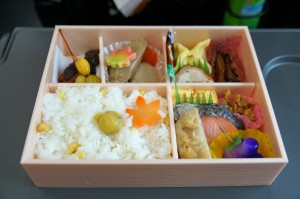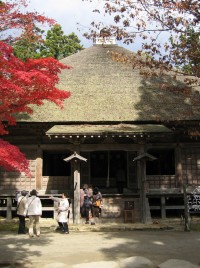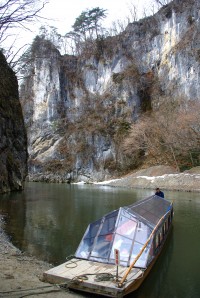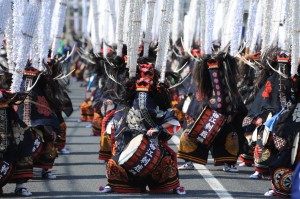
Ekiben (railway bento box). Image: Luke Lai
The life of a particle physicist is the same everywhere in the world one might say. It’s true that the physicist’s work life at the future ILC is easily predictable. Computing and data taking or analysis, meeting with colleagues, tons of coffee and tea, short lunch breaks at the cafeteria (with “electron” and “positron” menus?), preparing for future meetings in the afternoon, plus, for the lucky ones, night shifts for a detector or machine survey. I’m not going to tell you anything new about what you know already. Let me tell you the other side of the story, regarding your afterwork life at the Kitakami site. Put on your most comfy easy-to-take-off shoes – there is much to visit here – and follow me to the Tohoku region.
Please see our “Kitakami glossary” for explanations of terms.
Welcome onboard!
If you’re coming from abroad, you’ll probably land in Tokyo in the first place. You’re not arrived yet, but the experience begins here. To reach the candidate ILC campus, you’ll have to come onboard a Shinkansen “bullet” train, which will give you the opportunity to discover – at the peak speed of 320 km/h – the charms of the Tohoku region. By the time the ILC is constructed, the nearest station to the ILC campus will probably have become a main station of the Tohoku Shinkansen line, so you’ll arrive with an express train, 400 to 430 km later (and for those of my French colleagues who cherish their TGV, the Japanese train is way more comfortable!) Don’t forget to treat yourself to one of the bento boxes, sold on board or at the station of you departure. They’re all delicious!

Hiraizumi. Image noshadows
Talking of food… Bento boxes might become your best friends. Surely, in an international lab’s canteen you’ll probably have the choice between many kind of snacks and sandwiches, but bento boxes should be at your top list whether you consider to skip a proper lunch. They exist in many various kinds and often fit the local specialties, which are many… In Kitakami, you’ll be eating lots of different kinds of fish in various sorts of cooking of course, but you may be surprised to read that Iwate Prefecture is famous for its Maesawa Beef (to be tried in steaks and sukiyaki or shabu-shabu fondues), for dairies (from the Koiwai Farm) for its local Esashi apples and its sweet Nanbu Ichiro pumpkins (you may be lucky enough to try pumpkin sake — no kidding). Another very popular dish from the region are the mochi dishes (rice cakes), which are served as small bites in a nearly three hundred combinations of preparations, from mushrooms and fish to sweet green tea. Although mochi are famous all over Japan, there’s a special “mochi culture” in southern Iwate, where they are eaten at various special events. You may also try the Nambu Sembei (delicious crackers) or all kinds of noodles from soba (which Iwate people like so much that they organise Soba eating contests) to jajamen and Morioka reimen .
If you stay a few more days at the lab or live there, you should know that there is a must-see sight in Japan about 30 km from the future ILC detector halls: Hiraizumi, classified World Heritage Site by UNESCO in 2011. At its apogee during the XII century, Hiraizumi was a rich and prosperous town which could compete with Kyoto. From that ancient time survived a few treasures. Among those are the marvellous Golden Hall, a gold and lacquer covered structure at the Buddhist temple Chuson-ji, and the almost completely preserved garden of the Motsu-ji temple, known as one of the most beautiful gardens from that era. Culture-wise, you’d probably like to discover more about the famous writer Kenji Miyazawa, whose hometown was Hanamaki, Iwate Prefecture. He wrote in 1927, in the Night on the Galactic Railroad “if you study hard so that by experiment you can divide true thoughts from false thoughts—if you can just figure out how to set up the experiment—why then, Giovanni, faith will become just like science.”
Whenever you come to Kitakami, you’ll be enjoying the region’s nature all year long. During winter, ski resorts at Himekayu (to the west of the Oshu city centre) or at Esashi (at the northeastern end) will welcome you. In spring, you’ll enjoy the cherry blossoms. In August the rice fields will reveal all their poetic beauty. Outdoor sports like fishing, hiking (on Mt Murone or Mt Kurikoma for example) or golf are well appreciated by locals.
For leisure, you’ll also appreciate the closeness of tourist spots like the Geibikei gorge outside of Hiraizimu, which you can discover by gondola-like boat all year long (approved by the writer of this article during the freezing winter!). Don’t forget also a visit to the National Astronomical Observatory of Mizusawa (a district within Oshu), which hosts one of the four very-long-baseline interferometry VERA stations. All year long, you may participate in local festivals, among them is the popular local Japan beer festival of Ichinoseki City, the Kawasaki summer fireworks festival, the Daito Ohara Mizu-kake Matsuri (Water Pouring Festival at Ohara) or the Snow Festival of Shizukuishi Town in February, and the Shishi-Odori (Deer Dance ) in August, just to name a few.
Your trip to Kitakami is now almost ending and you may worry about what to take back home. Don’t show this post to your family and friends since they are many things you may pick. You may for instance choose your souvenir among thousands sorts of kokeshi dolls, originally from the Tohoku region, teapots from the world-famous Iwate Nambu Tekki ironware (save some weight in your luggage though, there are quite heavy), lacquerware or amber jewelry (Iwate is the only place where you will it find it).
Now it’s time to go back home. Let’s hope you’ll come back soon to Iwate… with the ILC this time.
ペリン・ロワイヤドゥジュ (Perrine Royole-Degieux)
Recommended links and reading
Images
For Further images, don’t miss our slideshow for a best overview of the region.
Local ILC support websites and brochures
ILC Pamphlet: Ray of Hope – Tohoku is ready to welcome the ILC
Iwate International Association webpage about the ILC
Oshu International Linear Collider website
Tourism in the area
A Trip to Iwate: Iwate Prefecture Tourism Portal Site
Travel to Tohoku: Tohoku’s Tourism Web Portal
Ichinoseki WIKI travel



Recent Comments